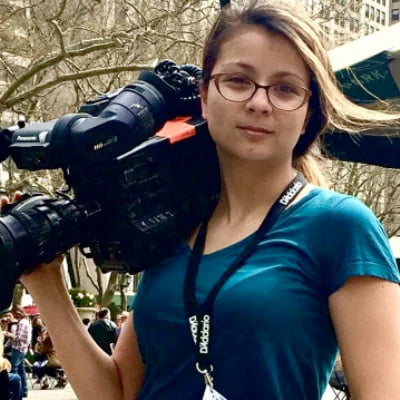Kevin DeLany — who recently retired as Vice President of News/Talk at Westwood One — is walking history.
“I was at the helm with President Reagan when he was caught on mic saying, ‘I’ve just signed legislation that will outlaw Russia forever. The bombing begins in 5 minutes,’” Kevin DeLany told Barrett Media over a phone call.
It’s difficult to sum up a legendary career that spans decades. Countless known names in talk, music, and beyond. In his own words, as we all wish him well in retirement, here is how Kevin DeLany grew from high school radio jock to legendary Vice President of Westwood One.
Krystina Carroll: Tell me about you. How did you get into the business?
Kevin DeLany: My time at Westwood One specifically included 45 years as producer, manager, director, and finally as Vice President of News and Talk programming. It was an extremely long run. I’m very lucky to have had such a run and had the experiences I’ve had. Most important thing I think I’ve had along the way are all the great people that I worked with, especially Bart Tessler, my colleague, who had the faith in me to pull it all off. The people at Westwood One are a great bunch to the audio product.
I grew up in the Philadelphia suburbs and was hooked on radio very early, listening to the boss jocks at WFIL [and] WYBG. My parents listened to stations like WIP. So, I listened to those stations, also. My first on-air job was at WLDB in Atlantic City, where we played country music. In high school, I was part of the team that did the morning announcements over the PA system. It was an action news-style format that we borrowed from WPVI Channel 6. That was the brainstorm of our guidance counselor. I was very successful at morning announcements and before I graduated high school, I was spinning jazz music at WWDB 96.5 in Philadelphia.
In 1975, that station switched to a talk format. It became the first FM talk station in the nation. I stayed on as the production manager for the station, creating the sound of the station — or imaging, as it came to be known today. I’ve had the great opportunity to learn the news/talk format from pioneers like Jerry Williams, Bob Grant, and local Philadelphia talkers.
KC: What was the what was that transition like from jazz to talk radio?
KD: It was kind of sudden, and it was prompted by the success of a suburban talk station in Philadelphia, whose program director kind of pitched the format change to the station owners at the time. Everyone at the station was let go, with the exception of me and Sid Mark, a Sinatra programer at the time. Sid was conscripted to do a talk program. He switched from being a Sinatra disc jockey to a talk show host. He kept his Sinatra programs also.
I switched from spinning jazz to the news department. So I just did news for the new talk station. So it was a bit of an adjustment, I think, for everybody given that the whole staff had turned over.
KC: You transitioned to the talk format, and then, I believe this station transitioned to Pop later. Is that correct?
KD: It did in 2000. The station switched to pop. It gave up on the talk format, and it’s been a music station ever since.
KC: So what made you stick with talk and not go back to jazz or do other things?
KD: Well, honestly, my love was radio and I was determined to do radio no matter what it asked of me. And I would do whatever I needed to do to stay involved in radio. I really loved the idea of radio. I’ll do jazz, I’ll do news, I’ll do pop, I’ll produce radio programs, which I’ve done all through my career. And it’s turned out pretty well for me.
KC: How did the news gathering change from the 1975 jazz transition to your retirement earlier this year?
KD: I don’t know that the news changed as much as my involvement in the news [changed]. Back then, it was a lot of rip-and-read where you would take the AP wire and turn that into a newscast. Throw in some news stories from the local newspaper, and do some research on items that were maybe breaking locally in Philadelphia. Put out a few calls and research the story a little bit. Put it together into a into a five-minute newscast. That was pretty traditional as is the typical five-minute newscast today.
What really changed for me was my involvement in it going from a local newscaster in Philadelphia to running a whole news division at the network that turned into more of a management position. [I was] involved in making coverage decisions. We had a White House reporter, a Capitol Hill reporter, we had 24/7 newscasts at the top and bottom of the hour. It was a whole news division which, along with my colleague Bart Tessler, I ran during the whole inception of Westwood One News.
KC: You’ve covered some of the biggest stories of our time: two wars in the Middle East, Democratic and Republican National Conventions. Is there one that really sticks out in your mind as, ‘wow!’?
KD: The story that really sticks out in my mind would have to be the 9/11 attacks. At the time, I was producing The Laura Ingraham Show out of our studios in Washington D.C. It was an evening program. The attacks happened in the morning and I watched it on television, like many other people did. [But unlike other people] I had to figure out how to make my way from my house to downtown Washington D.C. and this was [when] everybody in Washington D.C. was trying to get out.
I was able to take the Metro downtown amazingly enough, and when I got downtown. It was like a war zone. There was no traffic on the streets. There were National Guardsmen with rifles, there were military vehicles on the streets of D.C. and it was ethereal. It was something of an unbelievable time.
We went on the air that night with the latest of 9/11, and we probably had some of the first in the nation reaction with phone callers to our program discussing it. That’s the one thing that stands out for me.
KC: You’ve worked with so many incredible names and talents. What is it about them which really sticks out and where you say “You’re gonna be big”?
KD: I think it’s their professionalism. I mean, Larry King had a natural talent. He could do stand-up for one hour with no notes just off the top of his head. I’ve seen him do it. With Jim Bohannon and the other talk show hosts I’ve worked with, it’s their professionalism and commitment to the idea of being entertaining while also being somewhat informative and conducting a talk show. Not everybody can sit there in front of a microphone and talk for three hours at a time. It takes talent, and professionalism to be able to pull that off.
KC: You retired earlier this year. Congratulations! What is life like after radio?
KD: I’ll let you know when I get there. It’s always a difficult thing to move on from doing what you love, but I think I’m ready for a quieter time when the phone’s not ringing all the time. Most immediately, my wife and I are planning some traveling which we really love to do and I’m thinking of possibly dabbling in local government in the town where I live.
After that’s all over, I’ll consider what I want to do. Possibly some voice work or consulting, but right now I’m just looking forward to taking some time off.
KC: That’s wonderful. Congratulations. For people who are looking to follow in your footsteps — who have this love of radio — what’s your advice to them?
KD: Don’t let anything get you down. Keep plugging away. Believe in yourself and believe in the medium. When one door closes, another door opens and just keep faith in yourself and keep plugging away.
KC: Is there anything else you think I missed or would like to add?
KD: I’m very lucky to have had such a long run. I’ve done things such as working with Presidents in the Oval Office like Jimmy Carter and Ronald Reagan. I produced the Presidential radio address with Ronald Reagan from Camp David and Ireland. I’ve also worked with pop stars and country stars.
I don’t want to flatter myself by dropping a whole bunch of names but during the course of my career, I launched Country Countdown USA with Lon Helton with colleague and producer George Achaves. I launched The Laura Ingraham Show with fellow producer Lee Habib, and radio shows with Bill O’Reilly and many others. I’m very grateful and thankful for my career and I have to thank a lot of people for guidance, help, and support along the way. I’ll be eternally grateful.
Barrett Media produces daily content on the music, news, and sports media industries. To stay updated, sign up for our newsletters and get the latest information delivered straight to your inbox.

Krystina Alarcon Carroll is a news media columnist and features writer for Barrett Media. She has experience in almost every facet of the industry including: digital and print news; live, streamed, and syndicated TV; documentary and film productions. Her prior employers have included NY1 and Fox News Digital and the Law & Crime Network. You can find Krystina on X (formerly twitter) @KrystinaAlaCarr.



